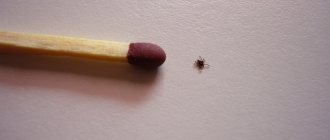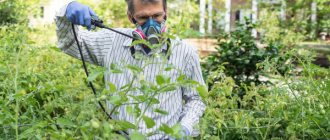If your indoor cat is clearly bothered by his ears, the most likely cause of the discomfort may be otodectosis, which is caused by mites. In this case, the pet requires immediate help. Infection with ear parasites dramatically reduces the quality of life of an animal and can even lead to its death. You will learn how to identify the symptoms of the disease and what medications to successfully treat it from our article.
Ear mites: what is it, where does it come from and why is it dangerous?
Ear mites are small parasites - Otodectes cynotis, localized in the external auditory canal of the animal and feeding on particles of the epidermis, blood and lymph. Their body is colored light yellow, has an elongated oval shape and does not exceed 0.6 mm in length. The vital activity of the parasite leads to injury to the sensitive surface of the inner part of the ear and contributes to the development of otodectosis, or ear scabies - a serious invasive pathology, accompanied in most cases by a bacterial infection. Severe advanced forms of otodectosis can lead to the death of the animal.
This is what an ear mite looks like under a microscope
Both dogs and cats can become infected with ear mites, but otodectosis is more common in representatives of the cat family. Ear mites are usually not dangerous to humans. People can carry the parasite and infect their pet.
How does infection occur?
There are several options for where ear mites come from. Animals that regularly walk outside suffer the most from parasite attacks. Not only ticks, but also other dangerous parasites lie in wait for them in the grass or garbage, in basements and attics. A healthy pet can become infected after contact with a sick animal, through care items - a comb, a carrier, etc. Owners are surprised when a tick appears on a pet that does not go outside. In this case, the culprit of the infection is the person himself - the parasite can be brought into the room on shoes, clothes, or hands. Often ticks are carried by flies or fleas.
Otodectosis is characterized by seasonality. In most cases, infection occurs during warm weather, which is favorable for the parasite. Outside the animal's body, Otodectes cynotis can exist for up to two months. If during this time the parasite does not find a host, it will die. Ear scabies most often affects pets under one year of age. Adults become infected from sick animals or when their immunity is weakened.
Why are ear mites dangerous?
Ear mites themselves are not dangerous and require simple therapy. But if left untreated, the disease can lead to serious consequences:
- intensive scratching will cause damage to blood vessels, which will lead to the formation of a hematoma;
- the skin of the inner surface of the ear will swell and become inflamed, and the pet will develop otitis media;
- the animal will gradually lose hearing;
- possible damage to the eardrum will cause inflammation of the middle and inner parts of the ear, which will ultimately lead to inflammation of the meninges and death of the animal.
On the left is the initial stage of ear mite infection, on the right is a very advanced case
Development of the disease
Since the tick feeds on tissue fluid and lymph, in order to get food for itself, it injures the upper layer of the epidermis of the external auditory canal with its chelicerae.
The release of tissue fluid in large quantities leads to the formation of a large number of crusts and scabs, and when microtraumas are contaminated with bacteria, a local inflammatory process (otitis externa) occurs.
In advanced cases, a perforation (rupture) of the eardrum , then the inflammation spreads first to the middle ear (otitis media) and to the membranes of the brain (meningitis), which often ends in death.
Up
Symptoms of infection
The symptoms that you need to pay attention to first in order to promptly detect otodectosis in a cat or kitten include:
- the appearance of redness and peeling of the inner surface of the ear;
- restless behavior of the animal - due to annoying itching, the cat shakes its head and constantly scratches its ears;
- release of fluid - exudate;
- the appearance of bald patches and areas with glued hairs in the lower part of the ear;
- the formation of dark brown scabs;
- unpleasant odor due to accumulations of pus;
- crooked head - in complicated forms of infection, the animal tilts its head towards the affected ear.
The owner should keep in mind that the consequences of a seemingly harmless pathology in the absence of therapy can be disastrous.
general information
In cats, both ears are usually infected, because... The animal itself transfers the parasite when washing from the diseased ear to the healthy one. Symptoms of infection soon appear and the pet experiences discomfort.
First sign
Once in the ear, the parasite eats away the skin and mucous tissue.
The cat suffers from severe itching, scratches continuously, and shakes its head.
How to spot a tick
It is difficult to see a tick with the naked eye, but you can identify it by its characteristic signs: brown discharge with an unpleasant odor accumulates in the cat’s ear canals. These are waste products of microscopic pests.
At the veterinary clinic, ear exudate is analyzed under a microscope. Using optics it is easy to detect parasitic arthropods.
What do parasites eat?
Pests feed on skin, blood, lymph, and ear secretions (wax). By burrowing under the skin, the parasites actively multiply and gnaw their passages right in it.
Numerous lesions in which waste products of mites accumulate, become inflamed, irritate the nerve endings, and cause itching.
Discomfort
The animal experiences itching and unpleasant sensations when mites penetrate the layers of the skin, gnawing and injuring them. Painful sensations develop later when otitis media develops.
Consequences of improper treatment
If the animal is treated at home using traditional methods or the situation is completely abandoned, the inflammation will penetrate into the middle ear and otitis media will develop. The disease will become chronic and the cat may lose hearing.
Is the animal contagious?
Cat ticks are not transmitted to humans. The parasite is not dangerous for either adults or children. These pests, like fleas, do not parasitize the human body, but can cause allergic reactions.
The owner of a sick pet is a carrier of otodectosis and is contagious to other animals.
The disease is transmitted from an infected individual to dogs, rabbits, and guinea pigs. Kittens most often suffer from this infection.
Where do ticks come from?
The parasite is not always transmitted from a sick individual to a healthy one; it can be brought into the house on the shoes of the owner.
If stray cats live on the landing of an apartment building, the infection will easily penetrate the apartment and the pet will suffer. Fleas, lice eaters and flies are also carriers of the infection.
Diagnostics
If you suspect an ear mite infestation, you should immediately contact a specialist. Only he will prescribe the optimal treatment option. Before visiting the veterinarian, the owner can verify for himself whether the animal has a parasite. For this you need a cotton swab and dark material. The stick should be used to clean out as much of the mass present in the pet’s ear as possible. Then it should be tapped over a dark surface in order to shake off the parasite. Having directed a bright light at the material and armed with a magnifying glass, you should observe the extracted secretions for some time. If after about a couple of minutes moving, small yellowish dots become noticeable, it means that your pet is developing otodectosis.
What is not allowed during processing is prohibited
The ears of adults and kittens are sensitive and need careful attention. Doctors do not recommend when cleaning:
- use soap, iodine, vinegar, alcohol lotions, hydrogen peroxide. These drugs can cause irritation and dryness;
- use cotton swabs, wrap cotton wool around matches. This can damage the eardrum or push debris into the ear canal instead of out.
Lumps or discharge in the ears are a signal to consult with veterinarians at veterinary clinics.
Treatment of ear mites in cats
Today, veterinary pharmacies sell many drugs to rid animals of ear mites. They are available in the form of ointments, drops, and aerosols. Despite the wide range, you should carefully select drugs for therapy because some do not help at all, others give only a temporary effect, and there are others that cause unwanted reactions and even complicate the course of the disease.
Drugs for the treatment of otodectosis must be selected taking into account the age of the animal and its condition - pregnancy, the presence of another disease. It is also important to follow the instructions exactly - the drugs are not harmless and, if used incorrectly and in excess of the dose, can harm the animal, especially if it is a kitten.
The procedures for the treatment of uncomplicated pathology are quite simple - the owner, using medications recommended by the veterinarian, can carry them out independently. In advanced forms of the disease, antibiotics and Otodectin injections may be needed.
To rid an animal of ear scabies, you will need drops or ointment directly to treat the pathology, preparations for cleansing the auricle and an insecticidal agent for application to the withers.
Drugs for the treatment of otodectosis should be purchased exclusively in special pharmacies. You should not take risks and buy medicines on the market.
The following remedies have proven themselves to be effective in the treatment of ear scabies:
- Otoferonol Gold. It has a complex effect - not only gets rid of infection, heals wounds, relieves inflammation, but also has an acaricidal effect - that is, it destroys ticks. The drug is not used for pets who are not yet two months old, and it is also contraindicated for females bearing cubs. The course of therapy is a double application with an interval of 7 days. Dose for cats: 3-4 drops in each ear canal.
- Amitrazine. Drops relieve inflammation, eliminate itching and have an acaricidal effect. The dosage should be calculated based on the recommendations specified in the instructions. Typically, for adult cats, a drop of 0.5 ml in each ear is sufficient. The procedure is carried out once a day, every three days. Usually it is enough to carry out 4-5 treatments. The drug is contraindicated in pregnant females.
- Decta. The drug contains an antibiotic. The product eliminates discomfort and destroys the causative agent of the disease. The animal is instilled with 3-5 drops in each ear. Treatment is carried out at intervals of 5 days. The drug is not used for the treatment of pregnant cats and kittens up to one month old.
- Aversectin ointment. The drug is used 2 to 4 times at weekly intervals. The product is contraindicated for cats bearing offspring and kittens under 2 months.
- Amidel-gel. Anesthetizes and destroys parasites. Treatment is carried out 2 to 5 times with an interval of 7 days. The product should not be used to treat kittens less than two months old and pregnant females.
For preliminary cleansing of the auricle, the budget product Bars or regular vegetable oil is suitable. To treat the withers, it is more convenient to use a spray - Cyodrin, Dermatosol, Frontline or any other that gets rid of skin parasites.
Rules for treating animals against parasites
Before using a medicinal drug to get rid of otodectosis, the auricle is cleaned with a special product or oil. Cleaning must be carried out even if the instructions for the medicinal product say that you can do without it. Cleansing will help the healing drops penetrate deep into the ear canal for a more effective effect. Use the cleaning product according to the instructions. When treating with vegetable oil, you should drip it into each ear, in the amount of 5 drops, and massage, blot the remainder with a cotton pad.
Do not clean the animal's ears with cotton swabs - this can promote deeper penetration of the infection and also cause injury.
After cleansing, you should drop the drug for the treatment of ear scabies into each ear of your pet, following the dosage recommendations specified in the instructions. Then you need to massage the base of the ear so that the product penetrates into hard-to-reach places. Next, you should hold your pet's head so that he does not shake out the medicine. The final stage of treatment is to wipe the inner surface of the ear and the area around it with a disc soaked in the same preparation.
To treat ear scabies in pregnant cats and kittens, special products should be used. Cleaning with sunflower oil, rubbing with hydrogen peroxide and instilling camphor oil in an amount of 2-3 drops can be one of the completely safe methods of treating otodectosis in kittens and pregnant animals.
During therapy, ear mites may move to the pet's body. In this case, you should treat the animal with an antiparasitic spray or apply special drops to the withers. After such treatment, you need to ensure that the cat or kitten does not lick itself for some time. The spray can also be applied to places where the animal usually rests.
To alleviate the animal's condition between treatments, Otonazole can be used. The drug has an anti-inflammatory, antimicrobial effect, and relieves annoying itching.
To speed up the healing process, you should take care of your pet’s immunity. His diet should be balanced, rich in useful elements and vitamins. A course of injections of immunomodulatory drugs, such as Gamavit or Tentravit, will also be useful.
Special drops should be used to clean the cat's ear.
Therapy and care
Many people are interested in how to treat ear mites in cats if there are other animals in the house? First, you need to isolate the sick person from other animals, throw out all bedding, rugs and other textiles on which the cat was located from the house. The apartment is thoroughly washed with disinfectants. The treatment of a sick animal is carried out wearing gloves and clothing that is not taken out of a closed room or closet.
The main rules for treating ear mites in cats include the following:
- If there are several furry inhabitants (cats or dogs) in the house, then everyone will have to be treated - regardless of whether they have the disease or not. For kittens and pregnant animals, it is worth using a gentle spray.
- Don’t forget about careful cleaning of your home. It is better to throw away bedding and rugs, or, as a last resort, boil them.
- It is worth remembering that a pet’s recovery directly depends on the strength of its immunity. Provide the patient with balanced, high-quality food and include vitamins in the diet.
- Clean your home more often. Remember that harmful microorganisms settle on various objects, in cracks in the floor, in fabrics and even in books.
- Never use products containing ethyl alcohol to treat ear mites in cats.
The duration of treatment for ear mites in cats will depend on the degree of neglect of the disease and on the drugs chosen. Simple cases can be resolved in one to three weeks. But in case of complications, when there is a secondary infection, the treatment process will drag on for several months.
Hygiene procedures and processing
All medications will be prescribed by a doctor. He will also tell you about the treatment regimen. Further actions will be approximately as follows:
- First of all, the surface of the ears is cleaned of crusts and dried particles, and the hair that gets in the way is trimmed.
- Warm hydrogen peroxide is carefully and slowly injected using a syringe. 2-3 ml is enough. You have to wait 15 minutes. You can replace this substance with olive oil.
- Using tweezers and a cotton swab, carefully clean out all the secretions. Dirty swabs are placed in a closed container. After completing the manipulations, they must be burned.
- After the ear canal has been thoroughly treated, 1-2 ml of acaricidal liniment or solution prescribed by a veterinarian must be administered, heated to 32 degrees (slightly warmer than room temperature).
- The auricle is bent and a small massage is given for about five minutes.
- Acaricidal powders are blown into each auditory organ or special aerosols and drops are used.
Such manipulations are repeated three times every week, but the exact schedule of procedures will be drawn up by a veterinarian. External cleaning of the ears is carried out daily.
Drug treatment
There are various medications for ear mites in cats, produced in Russia and abroad. The most popular are ointments for ear mites in cats or drops. There are also sprays that can be used to treat bedding, the cat’s body and its “personal items”. The ointment has the longest working time, but it is not as easy to apply as drops or spray. What remedies for ear mites in cats in the form of drops does modern pharmacology offer:
1. Amitrazine
. It is quite popular because it has a triple therapeutic effect: it destroys infections, fungal infections and subcutaneous pests. The substances begin to act immediately after instillation. This option is considered less toxic. The positive thing is that there are no negative effects.
2. Otoferonol
. This option is similar to the previous one. This is an excellent substance for ear mites in cats. Drops have low toxicity. They are comfortable and safe to use for treating kittens. It is only important to dose and apply the substance correctly. This drug must be injected into two hearing organs at once, even if only one is damaged.
3. Tsipam
. The medication has no side effects or contraindications. If the intervention is started in a timely manner, the treatment can be carried out only once. If the disease is advanced, you will have to repeat the manipulations every week until the condition finally improves.
4. Drops Bars
. They are instilled directly into the auditory organ, 3 ml each. If purulent inflammation is present, the dosage is increased. The areas need to be treated for seven to ten days intermittently. However, side effects often occur due to individual sensitivity.
Use ointment as an aid. The doctor will prescribe Aversectin ointment, Amidel-gel. Vedinol Plus, Ordermil.
Acaricidal powders are also used in veterinary medicine
:
- Phenothiazine
. It has a light yellow tint and a weak specific odor. The substance has a strong acaricidal, antimicrobial and anthelmintic effect. The drug is low-toxic and can be stored in closed packaging for quite a long time without losing its properties.
- Fine sulfur.
Light yellow powder that is insoluble in water. It should be used as part of a set of measures when infected with mites or fungi. The product can be purchased at any veterinary pharmacy, the drug is widely available.
A small dose of powder is poured into the hearing organ using paper. The advantage of the powder is its uniform distribution, the disadvantage is that it is quite difficult to apply. If your cat does not tolerate treatment procedures well, it is best to stop with drops.
Radical methods of therapy include the special antiparasitic drug Ivermectin, which is administered subcutaneously. The instructions contain the exact dosage, calculated based on the weight of the animal. This substance is very toxic, so it is prohibited for use outside veterinary clinics. It should not be used for small kittens, pregnant or weakened animals.
If otodectosis is advanced and signs of meningitis appear, then antibiotics, immunomodulatory elements, and vitamins are used for treatment. Such a “severe” patient is usually admitted to a hospital.
Folk remedies: useful and dangerous
At the first signs of otodectosis, you can try using folk remedies. In this case, it is necessary to carefully monitor the entire process so as not to prolong the disease. Before starting home therapy, be sure to consult with a veterinarian - you can call the veterinary clinic and agree on treatment measures over the phone.
Popular options include almond butter and strong green tea. They are used to treat mite-affected areas. It is important to observe personal hygiene measures here: carry out all manipulations only with special gloves. It is worth doing the procedures regularly, otherwise they will not give results.
All products must be fresh and at a comfortable temperature. To do this, they are slightly heated.
It must be remembered that some folk remedies for ear mites in cats can cause harm rather than benefit. For example, some owners prefer to use soda or crushed garlic, but they can lead to poisoning. Even worse is to use celandine, since it is extremely toxic not only to pests, but also to animals.
To avoid harming your pet, consult your doctor about each decoction or drug. Ideally, folk remedies should be combined with medications - only then the treatment will bring quick and positive results.
Folk remedies for ear mites
Folk remedies are recommended to be used only at the initial stage of infection, for prevention or as an auxiliary method of treatment. To cleanse the inner surface of the ear from crusts and scabs, you can use regular sunflower oil, as well as camphor or vaseline oil. For processing you will need cotton pads. Excess oil should be blotted off.
For disinfection purposes, you can use a 3% hydrogen peroxide solution. A cotton pad should only be slightly moistened with the product and gently wipe the infected area with it. In this case, you need to make sure that the peroxide does not flow deep into it.
A strong infusion of green tea is suitable as an antiseptic - a dessert spoon in half a glass of boiling water. Wipe the ears with a warm solution using a cotton pad.
Garlic is an excellent antiseptic, but it cannot be used in its pure form to treat your pet’s ears - it can provoke even greater irritation of the problem area. In the complex treatment of otodectosis, you can use a mixture of 2 tbsp. l. vegetable oil and half a chopped garlic clove. The composition is kept for a day in a dark and warm place, and then filtered.
If there are several pets living in the house, you need to protect them from contact with a sick animal, and also treat them for prevention.
Traditional methods: is it worth trying?
Often, when asking “How to quickly cure ear mites in cats,” almost all search engines will provide a huge amount of information on treating otodectosis using folk remedies: hydrogen peroxide, green tea, honey, mineral or olive oil, garlic gruel and much more.
Veterinarians urge you not to use traditional methods for self-treatment! You will only aggravate the problem: green tea will not affect the reproduction and activity of ear mites in any way, oil can contribute to the formation of cerumen plugs (since it is not absorbed through the skin and, accordingly, is not removed from the ear canal in any way), and garlic gruel and peroxide hydrogen will lead to severe irritation and inflammation.
Green tea will not help kitty cope with the parasite
Make an appointment with a veterinarian and honestly say which of the above methods you have tried on your own, this will tell the doctor which therapy to choose specifically for your pet
If your pet is nevertheless diagnosed with otodectosis, do not be sad, your veterinarian will tell you how to cure ear mites in a cat.
Up
This information is provided for informational purposes. Only your veterinarian should select the treatment regimen. Do not self-treat your pet. This is dangerous for her health.
Treatment of a kitten and a pregnant cat
You should choose drugs for the treatment of otodectosis in very young kittens and pregnant cats more carefully. Folk remedies can be called completely safe, but they can only help with mild, non-advanced forms of the disease. When studying the range of industrial drugs, you should choose those that are not absorbed into the blood.
The drug Stronghold, which is applied once, is approved for use in pregnant cats. It is low-toxic and, subject to dosage, absolutely safe. It is approved for use in kittens from 6 weeks of age. For babies, you should choose drops in lilac-colored packaging, and for adults, blue ones.
Another safe remedy for the treatment of ear scabies in pregnant and lactating females is the drug Frontline Spot On. It does not enter the animal’s blood, but is distributed in the epidermis and sebaceous glands. For kittens from the first days of life you can use Frontline Spray.
You should carefully choose medications for the treatment of ear scabies in kittens - some of them can harm your furry baby
How to treat and prevent
Treatment involves eliminating the cause of the disease, as well as relieving unpleasant symptoms and preventing complications.
- Acaricidal ointments are used to destroy pathogens, relieve inflammation and swelling. One of the most effective drugs is Akarobor. The product effectively reduces the number of pathogens, relieves inflammation and has an analgesic effect.
- Gel preparations Amidel-gel and Ivermek-gel are aimed at combating both larvae and adult ticks. The main mechanism of action is the formation of paralysis and subsequent death of the pathogen.
- Oridermil ear drops and its analogues get rid of the pathogen and have an anti-inflammatory effect.
- Preparations applied to the withers - Frontline. A drop of the drug is applied to the area between the shoulder blades. Thanks to rapid absorption, the acaricidal agent quickly enters the bloodstream.
- Sometimes parenteral administration of acaricides by injection is prescribed.
To prevent otodectosis in your pet, you should adhere to the following prevention methods:
- regularly examine the condition of the auricle;
- carry out sanitation of the ear canal once a month using special means;
- provide your cat with a healthy diet;
- exclude contact of the pet with an infected animal.
1111
Prevention of infection
It is no secret that preventing any disease, including otodectosis, is easier than treating it. For prevention purposes, the following rules should be observed:
- Carry out regular inspection and cleaning of your pet’s ears;
- avoid contact with suspicious animals;
- strengthen the cat’s immunity by adhering to the principles of proper nutrition, as well as ensuring that the pet takes the necessary vitamins;
- maintain pet hygiene;
- If you suspect the presence of a tick, you should immediately visit a specialist.
Description of the disease
Otodectosis is the parasitism of ear mites in the auricle of a dog. Mites multiply quickly because the conditions inside the ear are optimal for them.
During their life, mites damage the skin of the ear canal, cause severe itching, the dog itches heavily, scratches its ears with its claws (leaving open wounds). Various types of bacteria are introduced into wounds with claws.
As a result, we have an auricle infested with mites, bacteria and fungi on damaged skin. Together, these factors lead to severe inflammation that spreads deeper into the ear.











